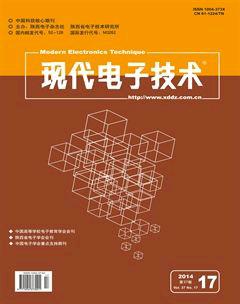改进的LCMV算法在多波束形成中的应用
何梅昕 束坤
摘 要: 基于线性约束最小方差(LCMV)算法的自适应波束形成技术,得到的方向图能保证期望信号方向增益最大,非期望方向形成零陷。但实际应用中由于不可避免的存在阵元位置误差、阵元相位误差及指向误差等(统称为相位误差),使约束的导向矢量与真实期望信号的导向矢量不一致,从而影响系统的性能。改进的LCMV波束形成算法——基于迭代二阶锥的唯相位波束形成技术,通过改变移相器的相位,使各阵元输出信号相位一致,在多个方向上形成主波束,阵列输出功率最大。
关键词: 线性约束最小方差算法; 迭代二阶锥; 自适应方向图控制; 唯相位波束形成技术
中图分类号: TN911.7?34 文献标识码: A 文章编号: 1004?373X(2014)17?0023?03
Abstract: The directional pattern of adaptive beam forming based on linearly constrained minimum variance (LCMV) algorithm can ensure the maximum signal gain in the desired direction and the null formation in undesired direction. In the practical application, the constrained orientation vector is inconsistent with the orientation vector of real desired signal due to the inevitable presence of sensor position error, array element phase error and pointing error (they are collectively called phase error), thus system performance is affected. The improved LCMV beam forming algorithm (phase?only beam forming technology based on iterative second?order cone technology) makes the phase of the output signal of each element consistent by changing the phase of phase shifter, so that the main beam is formed in multiple directions and the maximum output power of the array is realized.
Keywords: linearly constrained minimum variance algorithm; directional pattern; iterative second?order cone adaptive control; phase?only beam forming technology
0 引 言
自适应波束形成技术通过调整阵列发射或接收的加权,从而达到阵列方向图主瓣对准期望信号、零陷对准干扰的目的,已广泛应用于军事、雷达、声呐、声学、无线通信等领域。如果在自适应零点形成的同时进行低副瓣控制,可在一定程度上抵消自适应权不能适应突变干扰而带来的性能下降,这就是自适应方向图控制(Adaptive Pattern Control,APC)。本文对自适应方向图控制进行了研究,在LCMV算法的基础上提出唯相位多波束形成算法。该方法可在多个期望目标方向上形成多波束,在非期望方向上形成零陷。基于唯相位技术的多波束形成可以避免幅度加权造成的能量损失,为雷达多目标跟踪、电子干扰设备实现多目标干扰提供了一种新的思路。
基于LCMV算法的迭代二阶锥的唯相位多波束形成方法在相位扰动量比较小的情况下,目标函数和约束函数可以用相位矢量的泰勒一阶展开公式来近似,原来的非凸问题可以转化为凸优化问题,通过二阶锥规划方法求得使当前目标函数最小的扰动矢量;然后更新得到新的权重矢量,替代原来的权重矢量;重复上述过程直至满足终止条件,最后可以得到满足要求的唯相位权重。
1 基本信号模型与LCMV算法描述
首先来看阵列模型,等距线阵是最简单常用的阵列形式,几何结构如图1所示,将[N]个阵元等距离排列成一直线,阵元间距为[d]。
3 计算机仿真及评估
假设天线阵列是含有32个阵元的等距线阵,阵元之间为半波长间距。假设期望目标方向为[-30°,0°,30°],非期望目标方向为50°。协方差矩阵通过500次快拍数据得到,在仿真程序中,参数[M]与[N]设置为1.0和0.8,[δmax=0.02],当输出功率小于1.05时算法终止。图3为基于迭代二阶锥的唯相位算法的多波束形成方向图与功率谱图。通过仿真图我们可以看出主波束指向期望信号方向,在非期望目标50°方向有深深的零陷。
4 结 论
本文基于LCMV算法,在此算法的基础上,将改进的LCMV算法—迭代二阶锥的唯相位算法用于多波束形成。在相位扰动量比较小的情况下,目标函数和约束函数可以用相位矢量的泰勒一阶展开公式来近似,此时原来的非凸问题可以转化为凸优化问题;并通过二阶锥规划方法求得使当前目标函数最小的扰动矢量,然后更新得到新的权重矢量并代替原来的权重矢量,重复迭代上述过程直到满足终止条件。计算机仿真表明,本文提出的唯相位算法可以有效地在干扰方向形成零陷,在多个期望目标方向形成多波束。
参考文献
[1] 王俊勇.基于LCMV算法的天线方向图零陷加宽方法[J].中国科技在线,2007,13(2):26?28.
[2] GU Yu?jie, LESHEM Amir. Robust adaptive beamforming based on interference covariance matrix reconstruction and steering vector estimation [J]. IEEE Transactions on Signal Processing, 2012, 60(7): 3881?3885.
[3] GUO Q, LIAO G, WU Y, et al. Pattern synthesis method for arbitrary arrays based on LCMV criterion [J]. Electronics Letters, 2003, 39(23): 1628?1630.
[4] 路成军,盛卫星,韩玉兵,等.基于迭代二阶锥的唯相位波束形成[J].电子与信息学报,2014(2):266?270.
[5] ZHOU Philip Yuanping, INGRAM Mary Ann. Pattern synthesis for arbitrary arrays using an adaptive array method [J]. IEEE Transactions on Antennas and Propagation, 1999,47(5): 862?869.
[6] 张亦希,傅君眉,汪文秉.LCMV方法在卫星多波束天线赋形中的应用[J].电子学报,2002(3):332?334.
[7] 柳叶.发射数字多波束形成技术与工程实践研究[D].西安:西安电子科技大学,2011.
[8] 易锋,孙超.总体最小二乘算法模波束形成方法研究[J].声学学报,2013,38(1):35?41.
[9] KAJENSKI P J. Phase only antenna pattern notching via a semidefinite programming relaxation [J]. IEEE Transactions on Antennas and Propagation, 2012, 60(5): 2562?2565.
[10] CHOI W S, SARKAR T K. Phase?only adaptive processing based on a direct data domain least squares approach using the conjugate gradient method [J]. IEEE Transactions on Antennas and Propagation, 2004, 52(12): 3265?3272.
参考文献
[1] 王俊勇.基于LCMV算法的天线方向图零陷加宽方法[J].中国科技在线,2007,13(2):26?28.
[2] GU Yu?jie, LESHEM Amir. Robust adaptive beamforming based on interference covariance matrix reconstruction and steering vector estimation [J]. IEEE Transactions on Signal Processing, 2012, 60(7): 3881?3885.
[3] GUO Q, LIAO G, WU Y, et al. Pattern synthesis method for arbitrary arrays based on LCMV criterion [J]. Electronics Letters, 2003, 39(23): 1628?1630.
[4] 路成军,盛卫星,韩玉兵,等.基于迭代二阶锥的唯相位波束形成[J].电子与信息学报,2014(2):266?270.
[5] ZHOU Philip Yuanping, INGRAM Mary Ann. Pattern synthesis for arbitrary arrays using an adaptive array method [J]. IEEE Transactions on Antennas and Propagation, 1999,47(5): 862?869.
[6] 张亦希,傅君眉,汪文秉.LCMV方法在卫星多波束天线赋形中的应用[J].电子学报,2002(3):332?334.
[7] 柳叶.发射数字多波束形成技术与工程实践研究[D].西安:西安电子科技大学,2011.
[8] 易锋,孙超.总体最小二乘算法模波束形成方法研究[J].声学学报,2013,38(1):35?41.
[9] KAJENSKI P J. Phase only antenna pattern notching via a semidefinite programming relaxation [J]. IEEE Transactions on Antennas and Propagation, 2012, 60(5): 2562?2565.
[10] CHOI W S, SARKAR T K. Phase?only adaptive processing based on a direct data domain least squares approach using the conjugate gradient method [J]. IEEE Transactions on Antennas and Propagation, 2004, 52(12): 3265?3272.
参考文献
[1] 王俊勇.基于LCMV算法的天线方向图零陷加宽方法[J].中国科技在线,2007,13(2):26?28.
[2] GU Yu?jie, LESHEM Amir. Robust adaptive beamforming based on interference covariance matrix reconstruction and steering vector estimation [J]. IEEE Transactions on Signal Processing, 2012, 60(7): 3881?3885.
[3] GUO Q, LIAO G, WU Y, et al. Pattern synthesis method for arbitrary arrays based on LCMV criterion [J]. Electronics Letters, 2003, 39(23): 1628?1630.
[4] 路成军,盛卫星,韩玉兵,等.基于迭代二阶锥的唯相位波束形成[J].电子与信息学报,2014(2):266?270.
[5] ZHOU Philip Yuanping, INGRAM Mary Ann. Pattern synthesis for arbitrary arrays using an adaptive array method [J]. IEEE Transactions on Antennas and Propagation, 1999,47(5): 862?869.
[6] 张亦希,傅君眉,汪文秉.LCMV方法在卫星多波束天线赋形中的应用[J].电子学报,2002(3):332?334.
[7] 柳叶.发射数字多波束形成技术与工程实践研究[D].西安:西安电子科技大学,2011.
[8] 易锋,孙超.总体最小二乘算法模波束形成方法研究[J].声学学报,2013,38(1):35?41.
[9] KAJENSKI P J. Phase only antenna pattern notching via a semidefinite programming relaxation [J]. IEEE Transactions on Antennas and Propagation, 2012, 60(5): 2562?2565.
[10] CHOI W S, SARKAR T K. Phase?only adaptive processing based on a direct data domain least squares approach using the conjugate gradient method [J]. IEEE Transactions on Antennas and Propagation, 2004, 52(12): 3265?3272.

